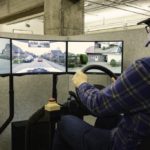 As people remain hesitant about driverless taxis and ride-hailing vehicles, teledriving might offer many of the same benefits, according to a new study from the University of Michigan.
As people remain hesitant about driverless taxis and ride-hailing vehicles, teledriving might offer many of the same benefits, according to a new study from the University of Michigan.
Teledriving can increase the number of cars on the road while reducing the number of drivers and the miles driven without passengers. This could make ride-sharing services faster and cheaper.
Remote control
Teledriving works by having a driver control a car remotely using video feeds from cameras on the car, along with sensors and augmented reality technology. Once a passenger is picked up, transported, and dropped off, the driver can switch to another car that needs service. Companies like Halo.Car and Vay are already using teledriving in Las Vegas.
One big advantage of teledriving is that drivers don’t need to be where the cars are. This can prevent the “wild goose chase” scenario in ride-hailing, where cars must travel long distances without passengers to meet demand. Teledriving can match supply and demand more efficiently.
“Teledriving allows a 30% to 40% reduction in drivers without hurting service quality, since extra vehicles can quickly reach customers,” the researchers explain.
Staying busy
Drivers can stay busier with teledriving, avoiding long idle periods. The rideshare company would also own the vehicles, reducing costs and risks for drivers. Teledriving could make driving a desk job, attracting more people to the profession.
Separating drivers from passengers could improve safety, especially for women who are more often targets of in-vehicle crime. However, teledriving systems must guard against reckless driving in an environment that feels like a video game.
The study used computer models to look at supply, demand, and road congestion. It found that having more cars than drivers can cut wait times during busy periods by reducing unproductive travel.
“This research aims to make ride-hailing and on-demand transportation services more efficient and cost-effective,” the authors say.
“Teledriving can let platforms operate with fewer drivers while keeping or even improving service quality, lowering operational costs and making these services more accessible. It could also reduce traffic congestion and waiting times, leading to a better experience for users.”
The study on teledriving’s benefits comes as efforts to launch autonomous ride services face setbacks, especially with safety concerns and reports of accidents involving driverless cars.
“Full autonomy might still be a long way off,” the authors conclude. “In the meantime, technologies like teledriving can bridge the gap by putting human drivers back in the loop.”